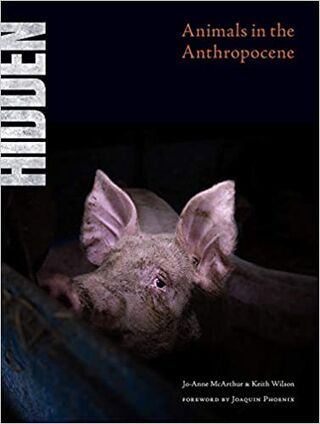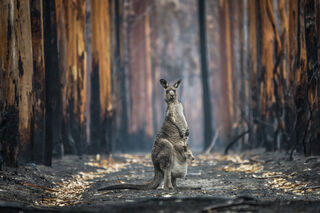Ethics and Morality
"Hidden": Animals Struggling to Coexist in the Anthropocene
An unflinching book of photography about our global conflicts with non-humans.
Posted June 18, 2021 Reviewed by Devon Frye
Key points
- The Anthropocene is often called "the age of humanity." But humans' rise has come at great costs to the animal world.
- Photography can be a powerful medium for change.
- A new book, "Hidden," uses photography to make a strong case for changing our relationships with the animal world.
Months ago, I learned of a riveting book called Hidden: Animals in the Anthropocene, edited by renowned photographer Jo-Anne McArthur and Keith Wilson, co-founder (with Britta Jaschinski) of Photographers Against Wildlife Crime.1,2 Here's what Jo-Anne had to say about their landmark work.
Why did you assemble and publish HIDDEN?
War photographer James Nachtwey assembled a book called Inferno, which documents genocide, famine, civil war, and what we do to one another, which moved me to the core. I knew animals needed a book like this. With the growing number of photographers who are turning their lenses to an invisible war, one that few people see, the war on animals, I knew we could create something historic, an indictment.
How does your new book relate to your background and general areas of interest and how does it differ from your previous books?
I’ve been documenting the plight of animals on all seven continents for almost two decades. I dreamed of making a book like this for years. My previous books, We Animals and Captive, are documents of my work over the years, but Hidden includes the work of forty photographers and journalists who speak on behalf of animals. Part of the effect is to start a conversation about the animals and also about how they felt this subject was important.

Who is your intended audience?
The target audience is principally the media and journalists who will bring the contents of this book into the homes of readers.
The audience is also the photography world. To them, we say: this subject matter is important. Wildlife and conservation photography, pet portraits, generic animal photography only go so far. They only cover a certain type of animal: those we love, or those who have ecological significance, or whom we've simply designated as important. There are a lot of other sentient, complex, relevant animals. They're important too, in and of themselves, but also as they overlap with human health and the destruction of diverse environments.
What are some topics you weave into your book and what are some of your major messages?
“What we can’t escape is the gnawing realization that amid our callous indifference to those animals that surround and depend on us, we know what we’re seeing is wrong.” This quote is from Martin Rowe’s essay "Hiding Behind Euphemisms." We included a section on this, highlighting the socially acceptable euphemisms we use to hide our mistreatment of animals.
The animals we use most in our daily lives are hidden away in factory farms, fur farms, and labs that use them in research and testing. We don’t say we’re eating a calf, for example, we say we’re eating veal. And in animal research, an animal is “sac’ed”—sacrificed—when they are finished being used. Words like these separate “human” and “animal,” “us” and “them,” “subject” and “object.” We're always hiding animals from ourselves. We build walls and euphemisms to cover any discomfort we might have. If we were to face the animals we keep in crates and cages and spend some time examining their lives there, and why they are there, we may not be able to enjoy ham or foie gras.

We chose not only to showcase the animals who are hidden from view, but also those who are suffering in plain sight but still hidden from our conscience. Those in live markets, used for entertainment or labour, as well as those left to perish from climate change, pandemics, and global catastrophes.
Are you hopeful that things will change for the better as people learn about the lives of the fascinating nonhumans with whom we share our magnificent planet?
Absolutely. Everyone is on a different journey with regards to seeing, thinking about, and acting for animals. We're so afraid of suffering which is why we avoid looking at suffering. We have a very limited understanding of it. Experiencing suffering—ours and theirs—is a learning opportunity to care more and to grow. It’s an opportunity for resilience. The closer we can get to it and see that we can take part without getting destroyed is galvanizing.
In addition to exposing the use of animals, Hidden also attempts to break new ground in the growing field of animal photojournalism. What is animal photojournalism?
Animal photojournalism (APJ) is an emerging genre of photography that captures, memorializes, and exposes the experiences of animals who live amongst us, but who we fail to see. At its core, the images in this pioneering field document the broader human-animal conflict and its resultant ecosystems of suffering.
From public and environmental health crises to zoonotic viruses, animals are inextricably linked to many areas of current global concern, and rightfully so. Our existence is intertwined, and the ethics of how we treat the other sentient beings with whom we share this planet are being called into question. Animal photojournalism aims to encourage swift and necessary change on behalf of the beings in the frame. APJ emphasizes the inclusion of all animals, particularly those historically underrepresented, like those kept within industrialized systems.
APJ is groundbreaking for two reasons. First, images in this genre demand radical empathy and self-awareness. Viewers must de-center themselves and consider the world through the eyes of a different species, while holding the truth of humanity’s undeniable role in the story. Additionally, it poses a fundamental threat to deeply embedded societal systems that continue, largely unchallenged. The act of seeking out these visual stories is itself an act of resistance.
References
Notes
Marc Bekoff in conversation with Jo-Anne McArthur.
1) Jo-Anne is an award-winning photojournalist, author and the founder of We Animals Media. She has photographed in over 60 countries and speaks internationally on the subjects of the human-animal relationship, social change, and empathy.
2) Part of the book's description reads: HIDDEN: Animals in the Anthropocene is an unflinching book of photography about our conflict with non-human animals around the globe. Through the lenses of forty award-winning photojournalists, HIDDEN shines a light on the invisible animals in our lives: those with whom we have a close relationship and yet fail to see. The animals we eat and wear; the animals we use for research, work, and for entertainment; the animals we sacrifice in the name of tradition and religion. HIDDEN is a historical document, a memorial, and an indictment of what is and should never again be.




